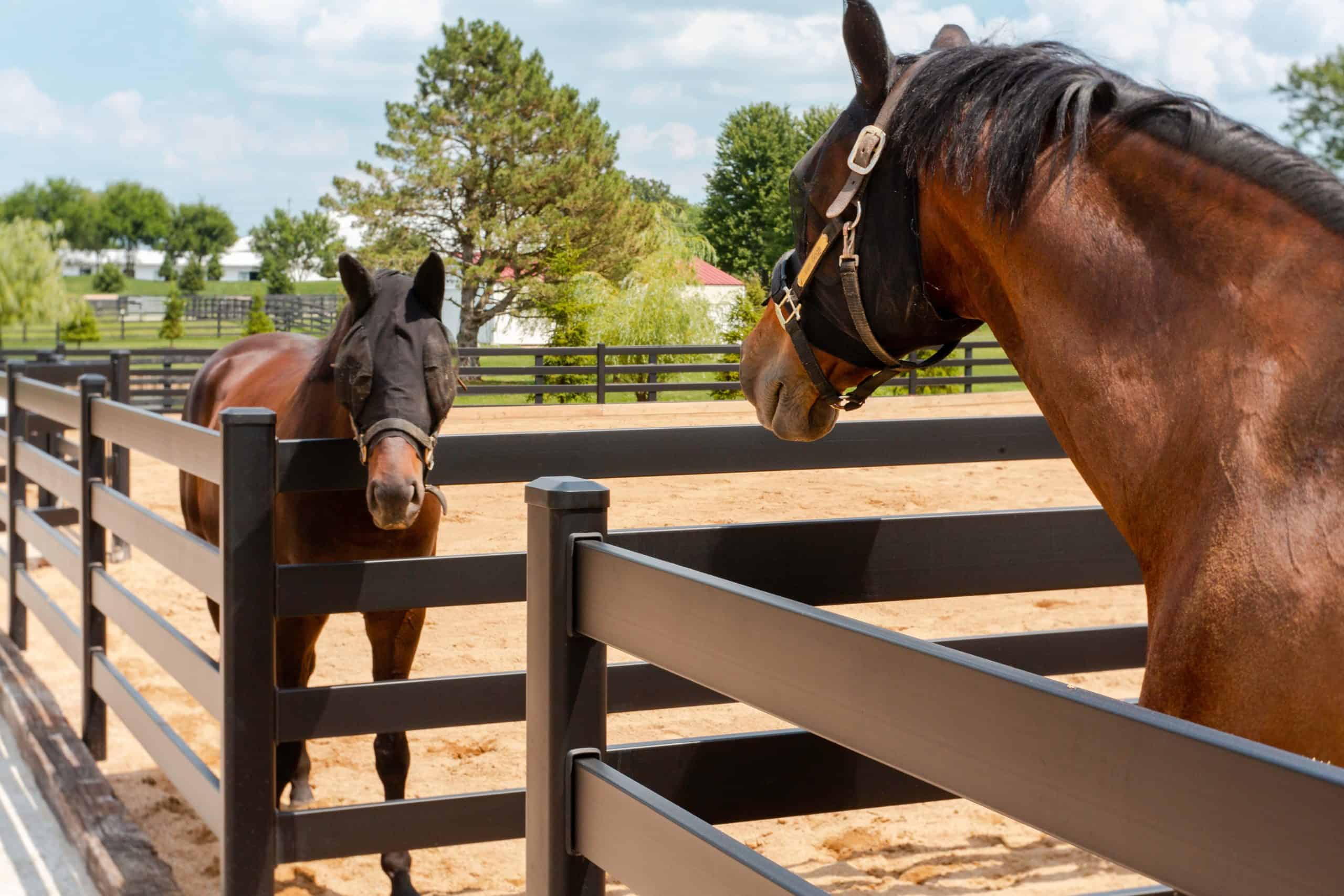Getting your equine fencing right isn’t just another farm decision. It’s about protecting animals that depend on you completely. It’s about your peace of mind when storms roll in or when you’re away from the property.
We’ve been in this business long enough to watch the mistakes repeat themselves. Folks choose materials based on initial cost instead of safety. They underestimate how hard horses are on fencing. They believe claims about “maintenance-free” products that start failing within seasons, not decades.
Truth is, your fencing decisions will follow you for years. Do it right, and you’ll barely think about those equine fence lines for the next 20 years. Do it wrong, and you’re looking at constant repairs, potential injuries, and eventually replacing the whole system anyway.
We’re not here to tell you what’s cheapest today. We’re here to share what actually works when you’re serious about protecting your horses and your investment. Because at the end of the day, that’s what matters to people like us who understand what’s at stake.
Let’s talk about getting it right the first time.
Horse Behavior and Fencing Requirements 101
Horses challenge fences in ways other livestock don’t.
Unlike cattle, horses don’t just test for strength. They explore with their lips and teeth. They scratch against posts. And they reach over and through gaps. And when startled, they might run straight into a fence without a second thought.
That flight response is important to understand. When horses spook, they react first and think later. A good fence needs to be highly visible in all conditions. We’ve seen too many injuries from horses running full-speed into fencing they simply didn’t see in time.
Seasonal behaviors matter too. In summer, horses seeking relief from insects will rub against anything solid. Come spring, even well-behaved horses get frisky and test boundaries. And let’s not forget the dynamics when new horses join the herd or when mares come into season.
The most dangerous fencing failures come from misunderstanding these basic behaviors. Wire that works fine for cattle can become a death trap for horses. Low visibility materials lead to collisions. Spaces between rails that seem reasonable become perfect places for a hoof to get trapped.
We’ve pulled horses out of these situations. We’ve comforted owners who blame themselves. And we’ve replaced countless “bargain” fences that weren’t designed with actual horse behavior in mind.
Your horses read your fencing differently than you do. They don’t see a boundary—they see something to investigate, to test, to interact with daily. Build with their perspective in mind, and you’ll sleep better for years to come.
5 Types of Equine Fencing Materials
When it comes to equine fencing, your material choice isn’t just about looks or budget. It’s about safety, longevity, and maintenance requirements. Here’s what real-world experience has taught us about each option.
| Material | Safety Rating | Lifespan | Maintenance | Initial Cost | Long-term Value |
| Steel Board | Excellent | 30+ years | Minimal | High | Excellent |
| Vinyl | Good to Fair | 15-25 years | Moderate | Medium-High | Good |
| Wood | Good | 7-15 years | High | Medium | Fair |
| Wire/Cable | Poor to Fair | 5-15 years | Moderate | Low | Poor |
| Electric | Fair (as supplement) | 5-10 years | High | Low | Good (as supplement) |
1. Steel Board Fencing
Steel board fencing represents the gold standard for horse containment. The safety profile is unmatched: no splintering, high visibility, and tremendous strength even on impact. Sure, steel requires the highest initial investment, but the lifetime cost often proves lowest when you factor in its 30+ year lifespan and minimal maintenance requirements.
Unlike other materials, steel won’t sag, warp, or become brittle with age and weather exposure. For serious horse operations where safety and longevity matter above all, steel board fencing simply can’t be beat.
2. Vinyl Horse Fencing
Vinyl has gained popularity for its clean appearance and relatively good safety profile. When properly manufactured and installed, it provides a smooth surface without risk of splintering. However, cheaper vinyl becomes brittle in cold weather and can shatter on impact. UV degradation affects all vinyl eventually, though premium products resist this longer.
While manufacturers tout vinyl as maintenance-free, that’s not quite true. It requires periodic cleaning and inspection, especially at connection points. The quality difference between budget and premium vinyl products is substantial—this isn’t a material where cutting corners pays off.
3. Wood Fencing
When properly constructed from appropriate hardwoods or treated lumber, wood fencing provides good safety and that classic aesthetic many owners want. But wood demands respect and maintenance. It will rot, warp, and splinter without regular attention. Posts heave in freeze-thaw cycles. Horses love to chew wood, creating both maintenance headaches and potential ingestion hazards.
We typically see 7-15 year lifespans depending on wood quality, treatment, and maintenance regimen. For owners willing to commit to the upkeep, wood remains a viable traditional option, but understand you’re signing up for a relationship, not just a purchase.
4. Wire and Cable Options
Wire fencing comes in many forms—from dangerous barbed wire (never appropriate for horses) to better options like no-climb horse mesh, woven wire, and high-tensile cable systems. The appeal is obvious: lower initial cost and visibility across your property. But we’ve seen too many wire-related injuries to recommend these as standalone solutions for horse containment.
Legs get caught. Skin gets sliced on broken strands. Visibility remains poor, especially in low light. If you must use wire for budget reasons, pair it with a top rail for visibility and use only horse-specific products designed to break away under pressure rather than cutting into flesh. Better yet, consider wire as temporary until you can upgrade.
5. Electric Fencing Systems
Electric fencing works through psychology rather than physical barrier strength. When properly installed and maintained, it’s effective as a boundary reinforcement. However, we rarely recommend it as a standalone primary fence for horses. Power failures, grounding issues from dry soil, and wire breaks create containment risks. The best use is as a supplement to physical barriers—running a hot wire inside a wood or vinyl fence to prevent chewing and leaning, or adding psychological reinforcement to an existing boundary.
Electric systems require non-stop maintenance: regular testing, vegetation management, and power source reliability. They’re most appropriate for interior paddock divisions or temporary arrangements rather than perimeter security.
Must-Have Safety Features for Equine Fences
We’ve seen what works and what fails when it comes to keeping horses safe. These aren’t fancy add-ons. They’re the difference between sound horses and preventable injuries:
- High Visibility: Horses need to see fencing clearly at all times, especially when spooked. The best fences use materials with substantial width—at least 4-5 inches for top rails, with colors that contrast against the background.
- Appropriate Spacing: No gap should be large enough for a hoof to penetrate, typically 8-9 inches maximum between rails. We see the most catastrophic injuries when horses get hooves caught in improperly spaced openings.
- Smooth Surfaces: Every surface a horse might contact should be free of protrusions, sharp edges, exposed fasteners, or splinters. Even minor surface defects can cause serious lacerations when a 1,200-pound animal slides against them at speed.
- Proper Height: Standard horses need fencing at least 54-60 inches high, while drafts, stallions, or jumpers require 72 inches or more. The bottom rail should sit 10-12 inches off the ground—high enough to prevent hoof entrapment but low enough to stop rolling horses from sliding underneath.
- Break-Away Features: Strategic “weak points” that give way under extreme pressure can prevent a trapped horse from suffering catastrophic injury. These engineered safety features have saved countless horses from what would otherwise have been fatal entrapments.
- Reinforced Gates: Entry points need secure yet accessible latches that clever horses can’t manipulate. Hardware should be recessed or covered, and every connection point reinforced against the constant strain that gates experience.
Make the Right Choice for Your Horses
We’ve spent generations watching what works for horses. Quality equine fencing isn’t just about containment—it’s about peace of mind. When you invest in proper materials, design, and installation, you’re protecting both your horses and your financial investment for decades to come.
At Buckley Fence, we understand the responsibility you feel toward your horses. We build fencing systems that stand up to the test of time and the challenges of horse behavior. Give us a call when you’re ready to discuss your property’s needs. Because some things are too important to compromise on. Your horses deserve nothing less.



